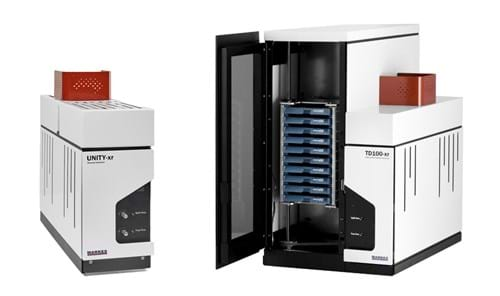IS 5182-28 is a standard method developed by the Bureau of Indian Standards (BIS) for the measurement of vapour-phase organic chemicals (C3–C30 hydrocarbons) in air and gaseous emissions, using pumped sampling and thermal desorption (TD) followed by GC–MS. It is applicable to workplace, indoor/in-vehicle and ambient air, as well as product emissions.
Why is IS 5182-28 important?
IS 5182-28 was introduced in response to rising concerns over air pollution in India, where increasingly hazardous levels of volatile organic compounds (VOCs) contribute to poor air quality. This method enables reliable, trace-level monitoring of VOCs using pumped sampling and TD–GC–MS – providing the sensitivity required for diverse environments, including ambient air, enclosed spaces, and emissions testing.
TD enables solvent-free sample preparation, improving sensitivity and reducing environmental impact compared with legacy solvent extraction techniques.

Replacing IS 5182-11: A step-change in VOC monitoring
IS 5182-28 marks a significant advancement over the older IS 5182-11 method, which relied on manual, solvent-based extraction. By adopting pumped sampling and TD–GC–MS, the new method delivers up to 1,000-fold greater sensitivity – enabling detection of VOCs at sub-ppb levels while also ensuring accurate quantification at higher concentrations often found in industrial or source emissions.
What is the methodology described in IS 5182-28?
- Active sampling onto sorbent tubes using a calibrated pump
- Recommended use of multi-bed ‘universal-type’ sorbent tubes packed with graphitised carbon black, porous polymers and carbon molecular sieves – enabling single-sample collection of a broad VOC range (C3–C30)
- Analysis by thermal desorption and gas chromatography–mass spectrometry (TD–GC–MS)
IS 5182-27 or IS 5182-28 – which to use?
Both IS 5182-27 and IS 5182-28 are modernised updates to IS 5182-11, using TD–GC–MS for sensitive, solvent-free VOC analysis. The key difference lies in their sampling approach:
IS 5182-27 – Passive (diffusive) sampling
Ideal for unattended, long-term monitoring where power supply is limited, such as remote sites or personal exposure studies. VOCs passively adsorb onto sorbent tubes during exposure.
IS 5182-28 – Active (pumped) sampling
Used when higher sensitivity or time-resolved data are needed. Pumped sampling collects larger sample volumes in shorter times, making it suitable for occupational hygiene, indoor air, emissions testing and more controlled monitoring scenarios.
These complementary methods allow users to select the right solution based on factors such as duration, sensitivity, convenience and site access.
What are the advantages of IS 5182-28?
- Wide analyte range – Multi-bed sorbent tubes capture a broad range of organic vapours (C3–C30), including aliphatics, aromatics, solvents and fuel components
- High sensitivity – Delivers up to 1,000× better sensitivity than solvent-based methods, allowing precise measurement of VOCs at trace levels
- Solvent-free – No hazardous solvents required, reducing waste and improving safety
- Cost-effective – Lower operational costs with no need for solvents or cryogens, and optional cylinder-free operation using Multi-Gas technology
- Scalable – Start with a UNITY-xr thermal desorber and upgrade to a ULTRA-xr autosampler for increased throughput
- Data confidence – Internal standard addition onto the focusing trap enhances reproducibility and compensates for drift
Products to support IS 5182-28 compliance
Markes manufactures and supplies all the products required for IS 5182-28 compliance. These include:
- UNITY-xr – Flexible TD platform with upgrade path to ULTRA-xr autosampler
- TD100-xr – High-throughput system for automated, unattended operation
- Sorbent tubes – Multi-bed, Tenax®, air toxics and material emissions configurations available
- ACTI-VOC Plus – Fast-flow VOC sampling pump for active collection onto TD tubes
- Cold traps & accessories – Enhance performance and reliability of TD systems

Summary of IS 5182-28 for VOC monitoring
IS 5182-28 represents a major step forward in air quality monitoring in India, enabling accurate, high-sensitivity analysis of VOCs across a wide range of applications. Markes International provides the expertise and tools to ensure full compliance and maximise analytical performance.
Relevant products
Further information
- On-demand webinar: The invisible toxic air we breathe (Presenter: Dr Sushil k. Tyagi)
- E-book: What is thermal desorption and how does it help air quality monitoring?
- Blog: Passive sampling in the workplace – Why thermal desorption is replacing solvent extraction
- Infographic: Solvent extraction vs. thermal desorption – Key considerations when looking to switch
- Application note: A review of sorbent-based sampling methods for volatile and semi-volatile organic compounds in air
- Blog: How long do sorbent tubes for thermal desorption last?
- News: Markes International and SepSolve Analytical play pivotal part in Delhi’s new ‘supersite’ air quality station
- Active sampling
Acknowledgement
Markes International acknowledges the invaluable contributions of Dr S.K. Tyagi, former Additional Director at the Central Pollution Control Board (CPCB), Ministry of Environment, Forest and Climate Change, Government of India, in the development of the Indian Standard Method IS 5182-28. With over 35 years of experience in air quality research and a distinguished career marked by significant achievements, including the establishment of the Air Toxic Laboratory at CPCB and contributions to the phase-out of lead in petrol, Dr Tyagi has been instrumental in shaping air quality standards in India. As a consultant for Markes International, Dr Tyagi’s expertise continues to drive advancements in thermal desorption technology and its applications for air quality monitoring in India.
Questions about IS 5182-28?
Our team is here to provide expert advice on air monitoring, and guidance on method setup, system configuration, and troubleshooting for IS 5182-28, to ensure compliance and data quality.




